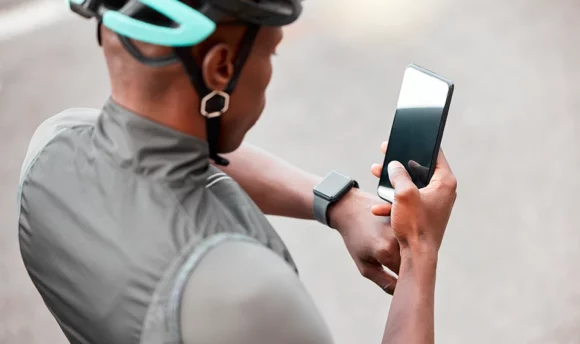Biking vs. Walking: Which Burns More Calories?
Cycling and walking both help you lose more weight. But which has a higher rate of calories burned?

So you’ve decided to lose weight and enhance the soundness of your cardiovascular system. There are lots of exercises that help with your journey of losing weight and increasing physical activity. Cycling and walking are two of them.
Cycling and walking are two aerobic activities that increase calorie burn, improve muscle strength and strengthen your cardiovascular system. However, depending on your fitness goal, you might be more interested in the one with a higher rate of calories burned.
This article shows you which burns more calories and for whom they’re best suited.
Which Burns More Calories: Walking or Biking?
Cycling is more efficient at burning calories than walking. According to Harvard Medical School, a 150-pound person will burn 288 calories cycling at a moderate speed in a 30-minute workout. Walking at the same pace and duration will help them burn 179 calories.
How many calories you burn with either of these exercises depends on your body weight and exercise intensity. For example, increasing your speed from a slow to moderate speed will lead to a more rapid calorie burn and weight loss.
If you aim to burn calories and lose weight within a short period, you should invest in a bike. Walking takes more time and is the workout for you if you want a more gradual process, but you’ll burn fewer calories.
How Many Calories Does Walking Burn?
According to this American Council on Exercise (ACE) calorie calculator, a 150-pound person who walks at a light pace of 2 miles per hour burns 68 calories in a 30-minute session. If you take it up to a brisk pace of 3.5 miles per hour, 129 calories get burned during the workout.
At a rate of 4 miles per hour, the person would have burned 170 calories.
How Many Calories Do You Burn Riding a Bike?
The 150-pound person riding a bike at a light pace of 5.5 miles per hour will burn 136 calories. If the ride is at a moderate cycling pace of 12 to 13 miles per hour, they’ll burn 272 calories.
And if they’re riding at a fast cycling speed of 16 to 19 miles per hour, they’d have burned 408 calories in 30 minutes and about 800 calories per hour.
Which One Is Recommended for Beginners?
Walking is the most recommended for beginners because it is a low-impact activity.
You need a routine that doesn’t strain your muscles and joints when you start working out. No matter how enthusiastic you are about your fitness journey, you shouldn’t go overboard and start with strenuous workouts.
Why Is Walking Beginner-Friendly?
Walking is suitable for all ages, weight ranges, and weight loss goals. Although you’ll burn more calories bicycling, walking can be easier on your ankles, hips, and knees.
Here are three more reasons why walking is considered a beginner-friendly exercise routine.
Walking is a low-impact exercise
Everyone has gotten injured at one point or the other. Some injuries are more intense than others, and some require you to stay off exercises that may worsen the injuries or cause you pain. That’s where low-impact activities like walking come in.
Walking allows you to train without unnecessary stress or weight on your knees and joints. In addition, it’s helpful when you have joint pain or return to exercising after a long time.
Walking is simple yet effective for burning calories with little effort. To boost your calorie burn rate, increase your speed by focusing on getting power from your lower body and engaging your abdominal muscles.
Want to raise the walking calories burned? Alternate between a 1–3-minute fast speed walk and a 30–60-second slow recovery walk. Walking has a lower calorie expenditure, so you’ll need to walk more to burn more.
It doesn’t require equipment
Unlike cycling, walking doesn’t require you to buy equipment. It works for people who cannot afford a bike but still want a low-impact workout that helps with your calorie burn.
Also, cycling can potentially get inconvenient. You’ll need to buy a bike and plan a convenient route. If you can’t ride there from your house, you’ll have to put the bike into a car or take it on a bus.
And if you can afford a stationary bike, you might not have enough space in your house to store it. Weather conditions may also make outdoor riding near impossible.
Walking does not require any of these hassles. You only need your body, good walking shoes, and a healthy appetite to feel the exercise burn those calories.
It fits people who have cardiovascular diseases
According to WHO, cardiovascular diseases (CVDs) refer to heart and blood vessel disorders. The most common cardiovascular disease is coronary heart disease. Walking is one of the few exercises people with CVD can use to maintain heart health and stay active.
A session of walking at a moderate pace helps the heart pump and get the blood flowing. Walking improves energy levels, blood pressure, and cholesterol levels. As it combats weight gain, it also improves overall heart health.
Aside from it being an excellent cardiovascular exercise for people who have CVDs, walking helps people who live a sedentary lifestyle chip in workouts in between their tasks. A study by the Centers for Disease Control states that walking is a way for adults to avoid inactivity.
Medical practitioners recommend a weekly dose of 150 minutes of moderate walking. Moderate here refers to walking and being able to talk without stopping to catch your breath.
Why Is Cycling Recommended for More Advanced Sportsmen?
Beyond keeping your heart’s health up, cycling is a highly recommended aerobic activity for sportsmen and women.
It can be pricey
Generally, you’ll spend more on cycling compared to walking. Unfortunately, not everyone can afford to buy a bicycle or cycling gear.
The type of equipment and gear you need for riding depends on if you’re riding outdoors or indoors. Outdoor riding requires a bicycle and safety gear like helmets, elbow and knee guards, etc. In addition, you’ll need a stationary bike and a storage room for indoor riding.
Injuries arising from outdoor riding accidents could also be more costly. Athletes are better equipped and experienced in handling exercise injuries. The cost may not be a problem for advanced athletes as they can include it in their training budget.
Cycling is perfect for toning muscles
Many muscles in the human body are engaged while cycling, resulting in a toned and defined muscle structure. Cycling firms up the muscles and creates an aesthetic and athletic look. Cycling also improves leg muscle tone as it isn’t a weight-bearing exercise like walking.
When you tone your muscles, you get increased stamina and improved posture. It builds endurance while targeting cardiovascular structure. Cycling primarily targets your lower body, specifically the leg muscles. It is also an excellent workout for toning the arm and core muscles.
While cycling engages the legs and glutes more, the stomach and back aren’t left out.
When the rider tightens their abs, they can push down on the pedal more efficiently and stronger. In addition, strengthened abs take off some pressure from the lower back muscles.
Increases muscle strength and gains
Increased muscle mass and strength are essential factors in the success of every athlete’s career. Athletes who want to improve lower body strength can include cycling on different terrains in their workout routines.
If you want to intensify your cycling exercise, pedal your bike up a steep incline and increase the number of calories burned.
A study that included ultra-endurance cyclists showed that after a 372.8-mile event, the cyclists didn’t lose skeletal muscle mass. However, there was significant weight loss through dehydration and fat.
A Word From Our Coach
Generally, it’s not easy to stay on course with your workout routines. If you need some extra motivation to take a walk or go on a leisurely bike ride, you could join or create a group.
Your friends or work buddies are a perfect place to start as they may want to lose weight and burn body fat with some walking and cycling. Some people prefer working out with strangers because they’ll get too comfortable. If that’s you, a workout group is more efficient than familiar faces.
While working on your lower body and engaging in leg toning exercises, remember to pay attention to your upper body and general bone density. Cycling causes master-level cyclists to have a lower bone mineral density (BMD) than non-athletes.
Luckily, you can tackle this problem with a well-rounded gym program where you strengthen the whole body with a full-body routine.
Women with type 2 diabetes should also engage in moderate cycling. It will help them lower their blood glucose levels.
Also, walking doesn’t perform much in appetite suppression and hunger reduction. If you’d like to eat less after your workout, you should choose cycling instead.
Conclusion
Both cycling and walking are excellent exercises when you’re trying to burn calories and need a cardiovascular exercise routine. However, we’ve solidified cycling as a better workout to burn more fat and walking as a more accessible option in comparing cycling with walking.
Remember, there’s no single perfect exercise that works on your entire body. So, you cannot depend on walking and cycling alone to burn calories and reach your fitness goals. Whichever one you choose will depend on your personal preference, health status, and body weight.

















































 Select your language:
Select your language: 








